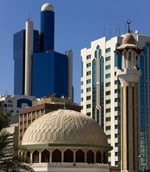Global
By Anita Hawser
 |
|
Abu Dhabi: Home of the world’s biggest sovereign wealth fund |
While the past couple of years have been challenging, to say the least, for investment funds in general, sovereign wealth funds (SWFs), some of which got their fingers burned piling into Western banks that later stumbled, managed to defy the odds and increase their aggregate total assets by 9% last year.
According to the 2010 Preqin Sovereign Wealth Fund Review, which covers 60 SWFs worldwide, on the back of last year’s recovery in global equity markets SWFs’ total assets under management increased from $3.22 trillion in 2009 to a current level of $3.51 trillion, with funds making up some of the ground they lost during the financial crisis. Norway’s government pension fund—known as Global—experienced one of the largest increases in assets, with growth of more than 25% in 2009, bringing total assets under management to more than $400 billion.
Although SWFs are generally secretive about their size and investments, Preqin estimates that the Abu Dhabi Investment Authority is the world’s largest SWF, followed by Norway’s Global and China’s SAFE Investment Company. These three funds together are believed to manage more than $1 trillion in total assets.
Having suffered disproportionately from the collapse in valuations of the Western banks since 2007, SWFs have worked hard to diversify their investment strategies beyond taking substantial stakes in financial institutions. This helps explain their recent uptick in performance, the Preqin report states, adding that almost 80% of all SWFs invest in public equities and fixed income. They also invest in alternative asset classes, with 55% allocating significant assets to private equity investments, 51% to real estate, 47% to infrastructure and 37% to hedge funds.
“The increase in the aggregate assets under management of sovereign wealth funds, which has been assisted by the start of the global recovery, demonstrates that their collective influence in the world of institutional investors has not diminished,” observes Sam Meakin, managing editor of the 2010 Preqin SWF Review. “Many SWFs that had put portfolio diversification plans on hold are now considering resuming these plans, and their appetite for alternative investments continues to increase.”
Not all the funds have seen their overall size increase, but that is not necessarily down to poor investment returns. Some governments have dipped into their countries’ SWFs to help cushion the blow of the economic slowdown. A case in point, says Meakin, is Russia’s Reserve Fund, which lost more than half its value over the past year, to $60 billion, as the government used it to cover the fiscal deficit.
Asia and the Middle East/North Africa (MENA) region boast the highest concentration of SWFs, with 40% of SWF aggregate assets residing in Asia and 35% in MENA. Europe accounts for 19%. Most SWFs are based on the proceeds of commodity exports, with 60% of all SWFs being funded by oil and gas exports; non-commodity sources account for the other 40%.



